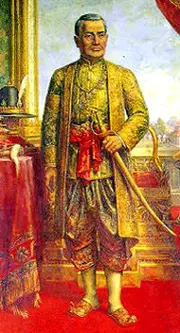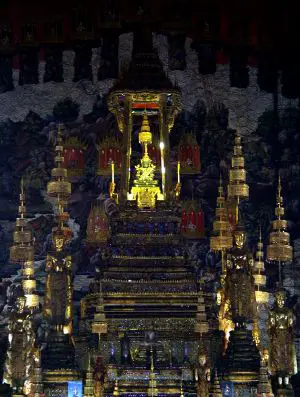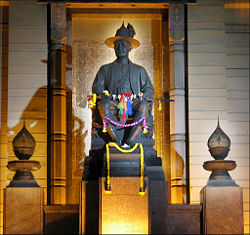Difference between revisions of "Rama I" - New World Encyclopedia
| Line 15: | Line 15: | ||
| queen = Queen [[Amarindra]] | | queen = Queen [[Amarindra]] | ||
| issue = 42 sons and daughters | | issue = 42 sons and daughters | ||
| − | | dynasty = [[Chakri Dynasty]] | + | | [dynasty = [[Chakri Dynasty]] |
| royal anthem = | | royal anthem = | ||
| father = | | father = | ||
| Line 25: | Line 25: | ||
|}} | |}} | ||
| − | '''Buddha Yodfa Chulaloke''' or '''Phutthayotfa''' (1737 – 1802), posthumously titled '''Rama I the Great''', was [[King of Thailand|King of]] [[Siam]] (now called Thailand) from 1782 to 1809, and the founder of the [[Chakri dynasty]] which rules Thailand to this day. He did much to place [[Buddhism]] at the center of cultural and religious life, as well as repelling the Burmese threst to Thailand's independence (land of the free). In fact, he extended Thai rule throughout central Indochina. | + | '''Buddha Yodfa Chulaloke''' or '''Phutthayotfa''' (1737 – 1802), posthumously titled '''Rama I the Great''', was [[King of Thailand|King of]] [[Siam]] (now called Thailand) from 1782 to 1809, and the founder of the [[Chakri dynasty]] which rules Thailand to this day. He did much to place [[Buddhism]] at the center of cultural and religious life, as well as repelling the Burmese threst to Thailand's independence (land of the free). In fact, he extended Thai rule throughout central Indochina. He is credited with the "reconstruction of the Thai State" and with recoverering Thailand's "place and presitge in the area" <ref>"King of the Charkri Dynasty", [http://www.soravij.com/kings.html Kings of the Chakri Dynasty] Retrieved October 6, 2007</ref>. |
| Line 35: | Line 35: | ||
===As King of Siam=== | ===As King of Siam=== | ||
| − | He was crowned on April 6 as Rama I; the date is now [[Chakri Memorial Day]], a [[public holidays in Thailand|public holiday in Thailand]]. His first act as king was to transfer the capital from Taksin's capital, Thonburi, to what became Bangkok, on the east bank of the Chao Phraya River. He set about reforming the adminsitration. He strengthened the Buddhist monastic order, convening a Council in 1788 to decide which scriptures should be considered orthodox. He salvaged Buddhist texts lost in the chaos after the sacking of Ayutthaya by the Burmese in 1767. The legitimacy of any Thai ruler is linked with patronage of Buddhism. In modern Thailand, Buddhist monks are allowed to travel without paying on buses and trains and have reserved seating areas in many stations and airport facilities. | + | He was crowned on April 6 as Rama I; the date is now [[Chakri Memorial Day]], a [[public holidays in Thailand|public holiday in Thailand]]. His first act as king was to transfer the capital from Taksin's capital, Thonburi, to what became Bangkok, on the east bank of the Chao Phraya River. He began building in 1782. Bangkok became a major commerical center. Trade with China and Chinese merchants thrived. He set about reforming the adminsitration. He strengthened the Buddhist monastic order, convening a Council in 1788 to decide which scriptures should be considered orthodox. He salvaged Buddhist texts lost in the chaos after the sacking of Ayutthaya by the Burmese in 1767. The legitimacy of any Thai ruler is linked with patronage of Buddhism. Rama I encouraged scholars and artists to settle in his new capital. In modern Thailand, Buddhist monks are allowed to travel without paying on buses and trains and have reserved seating areas in many stations and airport facilities. |
| − | As king, Rama I was a generous supporter of art and literature, commissioning and funding a Thai translation of the [[Hinduism|Hindu]] epic, the [[Ramayana]]. He built his palace, the [[Wat Phra Kaew]], to house the Emerald Buddha, a national treasure believed to have been made in India as early as 43B.C.E., and created a new code of laws, the ''Book of three seals''. He appointed the first [[Supreme Patriarch]] of [[Thai Buddhism]]. | + | As king, Rama I was a generous supporter of art and literature, commissioning and funding a Thai translation of the [[Hinduism|Hindu]] epic, the [[Ramayana]]. He may have partly translated with himself. He built his palace, the [[Wat Phra Kaew]], to house the Emerald Buddha, a national treasure believed to have been made in India as early as 43B.C.E., and created a new code of laws, the ''Book of three seals''. He appointed the first [[Supreme Patriarch]] of [[Thai Buddhism]]. |
[[Image:Emerald buddha.jpg|thumb|right|The Emerald Buddha]] | [[Image:Emerald buddha.jpg|thumb|right|The Emerald Buddha]] | ||
| Line 46: | Line 46: | ||
[[Image:Rama1saphanphut0609.jpg|thumb|left|250px|Statue of Rama I at the Phra Buddha Yodfa Memorial Bridge, Bangkok (1932)]] | [[Image:Rama1saphanphut0609.jpg|thumb|left|250px|Statue of Rama I at the Phra Buddha Yodfa Memorial Bridge, Bangkok (1932)]] | ||
| − | On his death, he was succeeded by his son prince Isarasundorn, who assumed the throne name of King [[Buddha Loetla Nabhalai]] (now posthumously titled Rama II). He was given the name Buddha Yodfa Chulaloke posthumously by king [[Rama III]], [[Nangklao]]. | + | On his death, he was succeeded by his son prince Isarasundorn, who assumed the throne name of King [[Buddha Loetla Nabhalai]] (now posthumously titled Rama II). He was given the name Buddha Yodfa Chulaloke posthumously by king [[Rama III]], [[Nangklao]]. |
| + | |||
==Legacy== | ==Legacy== | ||
| + | Rama's immediate successors, Rama II, III and IV were faced with dealing with the European colonial powers. Unlike its neighbors, Thailaind remained free from colonial rule. Her Kings negotiated with both the British and the French, to whom they made some trade concessions in return for an assurance from both powers that Thailand would remain a buffer-zone between their two empires. Rama I protected Thailand from subjection to another regional power, Burma. His heirs were not prepared to compromise Thai independence by allowing the great imperial powers to walk in and take over their state. Two aspects of Rama I's legacy contributed to their ability to retain freedom, against great odds. Firstly, Rama I positioned Buddhist values at the center of cultural life. Subsequently, these values became even more dominant, so much so that Thailand's own imperial ambitions within the region were abandoned in favor of developing a flourishing state with a rich culture ane a successful economy. Secondly, Rama I | ||
| Line 55: | Line 57: | ||
==External Links== | ==External Links== | ||
[http://www.humnet.ucla.edu/humnet/ealc/faculty/dutton/TSsite.html Dutton's Tay Son Timeline] | [http://www.humnet.ucla.edu/humnet/ealc/faculty/dutton/TSsite.html Dutton's Tay Son Timeline] | ||
| − | |||
| − | |||
| − | |||
| − | |||
| − | |||
| − | |||
| − | |||
Revision as of 18:46, 6 October 2007
| Buddha Yodfa Chulaloke (Rama I) | ||
|---|---|---|
| King of Siam | ||

| ||
| Reign | 6 April, 1782 – 7 September, 1809 | |
| Coronation | 6 April, 1782 | |
| Full name | Thong Duang (birth name) | |
| Titles | Chao Phraya Chakri (pre-reign military title) | |
| Born | March 20 1737 | |
| Ayutthaya | ||
| Died | 7 September 1809 (aged 72) | |
| Predecessor | Taksin (of Thonburi) | |
| Successor | Buddha Loetla Nabhalai | |
| Consort | Queen Amarindra | |
| Issue | 42 sons and daughters | |
Buddha Yodfa Chulaloke or Phutthayotfa (1737 – 1802), posthumously titled Rama I the Great, was King of Siam (now called Thailand) from 1782 to 1809, and the founder of the Chakri dynasty which rules Thailand to this day. He did much to place Buddhism at the center of cultural and religious life, as well as repelling the Burmese threst to Thailand's independence (land of the free). In fact, he extended Thai rule throughout central Indochina. He is credited with the "reconstruction of the Thai State" and with recoverering Thailand's "place and presitge in the area" [1].
Biography
The future king, whose birth name was Thong Duang was born on March 20, 1737 in Ayutthaya the Thai capital since 1350. His father was a court offical and a nobleman and an ethnic Mon. His mother was part-Chinese.[2][3][4][5]. After receiving his education in a Buddhist temple, his father sent him to become a squire for king Uthumphon, and it was at this moment that he met his friend Tak Sin, who would become King Taksin, Rama's future predecessor. Ayutthaya fell to a Burmese invasion in 1767. The king, fled, dying a few days later of starvation, to be succeeded by Taksin, who set up his capital at Thonburi. Rama rejoined the ranks of king Taksin's army under the name Chao Phraya Chakri. Chao Phraya Chakri was considered one of Taksin's most valuable generals.
Military Service
While serving as Taksin's general, Rama conquered Vientiane in 1778-79, putting the country under vassalage, and removing its Emerald Buddha and Phra Bang to Thonburi. His subsequent campaigns extended Thai rule into Laos, Cambodia and into the Northern part of the Malay peninsula. On April 4, 1782, Taksin was declared mad after a coup d'etat and was later executed. Rama was in Cambodia at the time. He quickly returned to Thonburi, where he was declared king on 6th April, establishing the Chakri dynasty.
As King of Siam
He was crowned on April 6 as Rama I; the date is now Chakri Memorial Day, a public holiday in Thailand. His first act as king was to transfer the capital from Taksin's capital, Thonburi, to what became Bangkok, on the east bank of the Chao Phraya River. He began building in 1782. Bangkok became a major commerical center. Trade with China and Chinese merchants thrived. He set about reforming the adminsitration. He strengthened the Buddhist monastic order, convening a Council in 1788 to decide which scriptures should be considered orthodox. He salvaged Buddhist texts lost in the chaos after the sacking of Ayutthaya by the Burmese in 1767. The legitimacy of any Thai ruler is linked with patronage of Buddhism. Rama I encouraged scholars and artists to settle in his new capital. In modern Thailand, Buddhist monks are allowed to travel without paying on buses and trains and have reserved seating areas in many stations and airport facilities.
As king, Rama I was a generous supporter of art and literature, commissioning and funding a Thai translation of the Hindu epic, the Ramayana. He may have partly translated with himself. He built his palace, the Wat Phra Kaew, to house the Emerald Buddha, a national treasure believed to have been made in India as early as 43B.C.E., and created a new code of laws, the Book of three seals. He appointed the first Supreme Patriarch of Thai Buddhism.
====Expanding the Kingdom===+
Rama I continued Taksin's task of saving the newly reunited country from attack by Burma, and repulsed several Burmese invasions. By the time of his death, not only had Burma been repulsed but the entire central portion of Indochina was under Siamese rule.
On his death, he was succeeded by his son prince Isarasundorn, who assumed the throne name of King Buddha Loetla Nabhalai (now posthumously titled Rama II). He was given the name Buddha Yodfa Chulaloke posthumously by king Rama III, Nangklao.
Legacy
Rama's immediate successors, Rama II, III and IV were faced with dealing with the European colonial powers. Unlike its neighbors, Thailaind remained free from colonial rule. Her Kings negotiated with both the British and the French, to whom they made some trade concessions in return for an assurance from both powers that Thailand would remain a buffer-zone between their two empires. Rama I protected Thailand from subjection to another regional power, Burma. His heirs were not prepared to compromise Thai independence by allowing the great imperial powers to walk in and take over their state. Two aspects of Rama I's legacy contributed to their ability to retain freedom, against great odds. Firstly, Rama I positioned Buddhist values at the center of cultural life. Subsequently, these values became even more dominant, so much so that Thailand's own imperial ambitions within the region were abandoned in favor of developing a flourishing state with a rich culture ane a successful economy. Secondly, Rama I
Notes
- ↑ "King of the Charkri Dynasty", Kings of the Chakri Dynasty Retrieved October 6, 2007
- ↑ Baker, Chris
- ↑ "Rama I," Encyclopedia Britannica Rama I Retrieved October 6, 2007.
- ↑ Down Sampeng Lane: The Story of Bangkok's China Town
- ↑ "Thailand: Doing Business in," Reference for BusinessThailand, doing business in Retrieved October 6, 2007.
External Links
Credits
New World Encyclopedia writers and editors rewrote and completed the Wikipedia article in accordance with New World Encyclopedia standards. This article abides by terms of the Creative Commons CC-by-sa 3.0 License (CC-by-sa), which may be used and disseminated with proper attribution. Credit is due under the terms of this license that can reference both the New World Encyclopedia contributors and the selfless volunteer contributors of the Wikimedia Foundation. To cite this article click here for a list of acceptable citing formats.The history of earlier contributions by wikipedians is accessible to researchers here:
The history of this article since it was imported to New World Encyclopedia:
Note: Some restrictions may apply to use of individual images which are separately licensed.

